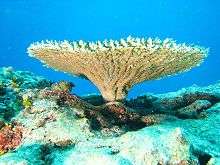Euphyllia glabrescens
Euphyllia glabrescens is a species of large-polyped stony coral belonging to the family Caryophylliidae. Its common name is the torch coral due to its long sweeper tentacles tipped with potent cnidocytes.[2] It is a commonly kept species in the marine aquarium hobby, particularly specimens from Indonesia and Fiji, who fulfilled annual export quotas of 28,000 and 6,000 pieces, respectively, in 2005.[3]
| Euphyllia glabrescens | |
|---|---|
| Scientific classification | |
| Kingdom: | Animalia |
| Phylum: | Cnidaria |
| Class: | Anthozoa |
| Order: | Scleractinia |
| Family: | Euphylliidae |
| Genus: | Euphyllia |
| Species: | E. glabrescens |
| Binomial name | |
| Euphyllia glabrescens Chamisso & Eysenhardt, 1821 | |
| Synonyms | |
|
List
| |
Description
Euphyllia glabrescens is a colonial coral with a phaceloid formation of corallites 20-30 millimeters (0.8 - 1.2 inches) in diameter and spaced 15-30 millimeters (0.6 - 1.2 inches) apart. Walls are thin, with sharp edges. Polyps have large tubular tentacles with knob-like tips.[4] It can be a number of colors, and is often bicolored with contrasting tentacles and polyp tips.
_with_polyps_extended.jpg) Green, yellow polyps
Green, yellow polyps- Beige, green polyps
 Beige, white polyps
Beige, white polyps
Distribution & habitat
This is a widely distributed species, rare to the Red Sea and the Gulf of Aden, while uncommon through the northern Indian Ocean, the Persian Gulf, the central Indo-Pacific, Australia, Southeast Asia, southern Japan and the East China Sea, Micronesia, and American Samoa.[3]
Euphyllia glabrescens can be founds in depths of 1 to 35 meters (3 – 115 feet) in a wide range of reef environments [3]
References
- Turak, E., Sheppard, C. & Wood, E. 2008. Euphyllia glabrescens. The IUCN Red List of Threatened Species. Version 2016.1.
- Jones, A. M. (2011). "Raiding the Coral Nurseries?". Diversity. 3 (3): 466–482. doi:10.3390/d3030466.
- International Union for Conservation of Nature and Natural Resources (2014). "Euphyllia glabrescens". doi:10.2305/IUCN.UK.2014-1.RLTS.T133256A54224297.en. Cite journal requires
|journal=(help) - Australian Institute of Marine Science (2013). "Euphyllia glabrescens". Corals of the World. Retrieved 23 July 2016.

